THE RWANDAN GENOCIDE IN FILM, AND A SUNDAY IN KIGALI: WATCHING WITH A PIERCED EYE
DOI:
https://doi.org/10.17742/IMAGE.scandal.4-1.10Abstract
Susan Sontag reminds us that film and photography have an extremely democratic heuristic poetics, and are quasi-universally accessible for signification, though at the same time, it almost always implies a prime target audience. The many films that have come out on the Rwandan genocide (1994) are no exception. Film has been a prime access source to this bloody event and dominates, particularly in the West, our remembrance and understanding of one of the most intense and grueling political conflicts in African history. All these films struggle with a compulsive need for structured narration, whether it is in their fable, or in the visual representation itself, while the historical events were certainly not experienced as part of a linear structure. At the same time, the films aim for historical credibility, or truthfulness, which is rendered through a variety of filmic approaches. The article discusses the fictionalization of genocide through film, and problematizes the quasi-unavoidable documentary effect of filmic iteration. Robert Favreau’s Un Dimanche à Kigali is analyzed in greater detail, as it offers specific strategies to the problem of filmic representation of genocidal violence.Downloads
Published
2013-08-22
How to Cite
Defraeye, P. (2013). THE RWANDAN GENOCIDE IN FILM, AND A SUNDAY IN KIGALI: WATCHING WITH A PIERCED EYE. Imaginations: Journal of Cross-Cultural Image Studies, 4(1), 82–105. https://doi.org/10.17742/IMAGE.scandal.4-1.10
Issue
Section
Articles
License

This work by https://journals.library.ualberta.ca/imaginations is licensed under a Creative Commons 4.0 International License although certain works referenced herein may be separately licensed, or the author has exercised their right to fair dealing under the Canadian Copyright Act.




